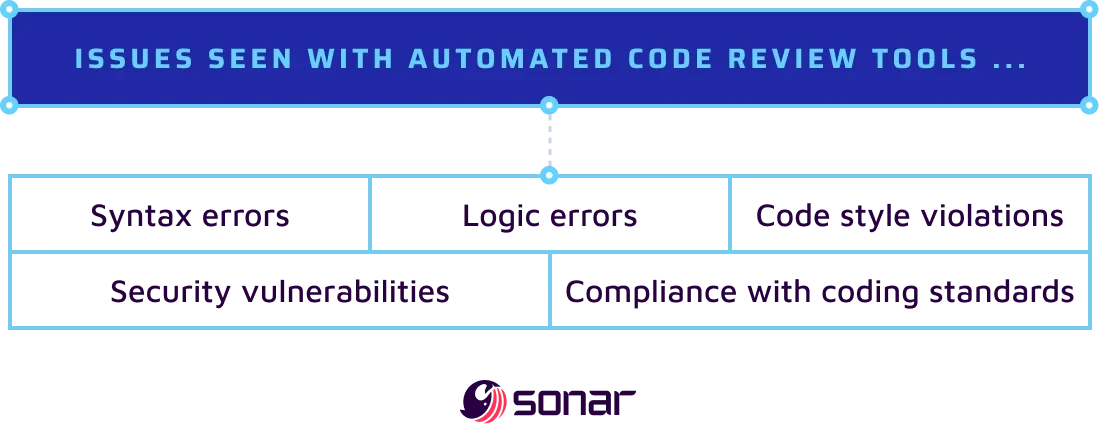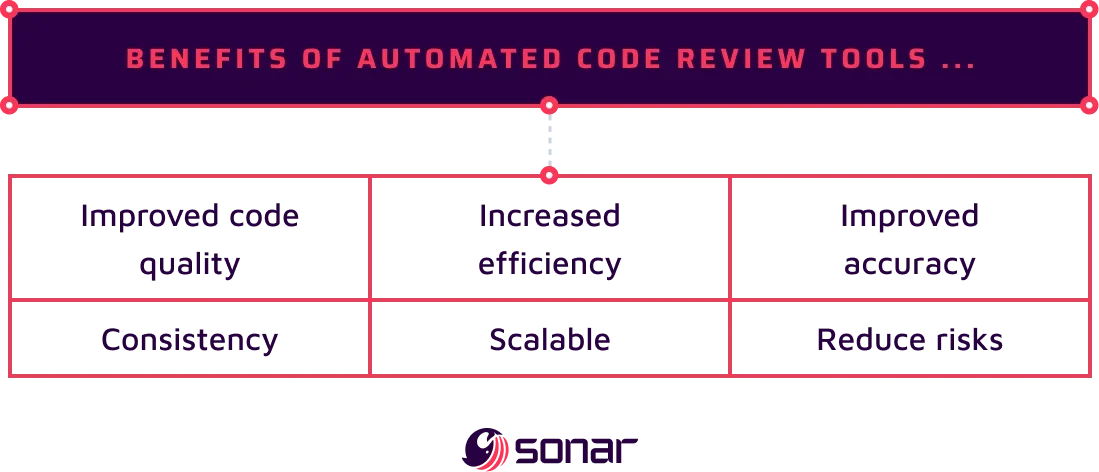What is a code review?
Code review is a software quality assurance process where one or more persons or tools systematically examine and evaluate the source code of a program. One or more of the individuals reviewing the code need to read the code and identify any issues within the code.
The goal of code reviews is to identify bugs, improve code quality, and follow best practices and standards for coding.
Code reviews are typically performed before integrating the code into the main branch of the codebase and can also be done periodically for existing code to maintain its quality over time.
The process of code review helps catch errors early in the software development lifecycle (SDLC), fosters collaboration among team members, and ultimately leads to a more robust and reliable software product.
There are code review tools that can assist with automating the review process. These review tools can check for coding errors and provide recommendations for improving the code.
If the code review is performed manually, at least one of the individuals should not be the author of the code.
What is a peer code review?
Peer code review is a software development process in which one or more developers examine code generated by a peer before merging it into the main repository. This method is intended to improve software quality, detect defects and vulnerabilities early, share expertise among team members, and ensure coding standards are followed.
Peer code review can be done in a variety of ways, but the primary method is for the reviewer to read the code and look for errors. The code reviewer may also question the author about the code in order to better grasp its intent.
What is an automated code review?
An automated code review is a process in which static code analysis tools are used to automatically review and analyze the source code for potential issues and coding standard violations. Automated code review accelerates the identification and resolution of code issues and improves code quality (reliability, security, maintainability).
Different from peer review where a human is manually looking through code line by line, automated code reviews utilize tools to detect a wide range of errors from bugs and vulnerabilities to styling issues. As compared to manual peer review, automated code review tools can quickly and efficiently scan codebases to identify defects, security vulnerabilities, coding style violations, and other potential problems.
Some common issues normally highlighted with automated code review tools include:
- Syntax errors
- Logic errors
- Security vulnerabilities
- Code style violations
- Compliance with coding standards

These kinds of code inspections are essential in current DevOps and Continuous Integration/Continuous Deployment (CI/CD) processes.
Why is a code review important?
Code review is an important method for increasing software quality. It can aid in the detection of defects and errors, the improvement of code readability, security, and maintainability, and the exchange of knowledge early in the development process. By implementing code reviews earlier in the development life cycle, you can save time and money later on in the process.
By utilizing code reviews earlier on also, it can be made easier for future developers to work on and understand the code that is evaluated. This helps promote knowledge and collaboration among team members along with fostering shared code ownership.
What is a secure code review?
Secure code review is a subset of code review that focuses on detecting potential security flaws and weaknesses in a codebase. Its goal is to ensure that the application’s codebase is resistant to potential security threats and follows secure coding practices. It's a proactive strategy that aids in the detection and correction of security flaws before the application goes live. This can prevent attackers from exploiting weaknesses in the code.
Secure code review can be performed manually, by a security professional or developer reviewing the code line by line, or automatically, with secure code review tools that scan the code and flag errors. The code reviewer looks for common security issues in the code such as injection flaws, Cross-Site Scripting (XSS) vulnerabilities, and authentication and authorization issues.
Secure code review is an important aspect of the software development lifecycle (SDLC) since it can assist in identifying and correcting security flaws before they are exploited by attackers. The reviewer looks over code to identify known vulnerabilities like those mentioned in the OWASP Top 10 along with concerns unique to the application or dev environment.
Typically, the process includes both manual and automated reviews. Manual reviews can evaluate the logic and design of the code, identifying issues that other tools may overlook. Automated tools rapidly scan vast codebases for common vulnerabilities and coding errors, increasing the efficiency of the review process.
How to do a code review
Code reviews are an essential element of the software development process that can considerably improve the final product's quality.
Here's a step-by-step guide to performing a code review:

Prepare for the review
Set some time aside to become accustomed to the code before beginning the review. This includes reading the code, knowing its purpose, what the code is supposed to do, and comprehending the team's coding standards.
Understanding the goal and context of the code modification is critical.
Start the review
You can begin the review once you are familiar with the code. The review should be a two-way dialogue between you and the code's author. You should ask the author questions regarding the code, and they should explain their decisions.
Review the design
Determine whether the suggested solution is consistent with the application's existing architecture and design patterns. If the implementation diverges significantly, it is worthwhile to demonstrate why and how the alternate solution improves the project.
Check correctness
Ensure that the code functions as expected and achieves its intended goal. This could include manually executing and testing the code, examining automated test results, or simply confirming that appropriate testing was performed.
Look for any problems as you go through the code. This involves searching for logic mistakes, security flaws, performance difficulties, and readability issues.
Review code style and standards
The code should follow the coding style and standards of the team. Code style consistency makes the code easier to read and understand. This includes correct indentation, naming conventions, and code organization.
Check for code smells
Code smells can indicate more serious issues in the code. Large classes or methods, redundant code, magic numbers, or excessive complexity are examples. If you notice a code smell, it's worth talking about and possibly refactoring.
Examine Readability
The code should be easy to read and understand. Good code usually is self-explanatory.
Review tests
Ideally, code changes should be accompanied by tests. Ensure that there is appropriate test code coverage and that the tests are testing the functionality correctly.
Evaluate security and performance
Analyze the code for possible security vulnerabilities and performance issues. If the code adds new features, make sure they don't have an adverse effect on the application's performance or security.
Provide feedback
When you notice problems, give clear, constructive comments. Explain what's wrong, why it's a problem, and, if possible, provide a solution. Be courteous and professional in your remarks.
Communicate
If you have any concerns or questions, don't be afraid to ask them. It is preferable to clarify uncertainty rather than make assumptions. Code review is more than just looking for bugs; it's also an opportunity for discussion and learning.
Summarize your review
When you're through, write a summary of your findings. Depending on the conclusion of your review, you can approve the modifications, suggest revisions, or just include comments.
Resolve issues
After reviewing your suggestions, the developer should be able to remedy the issues. This could include changing the code or justifying their decisions.
The purpose of a code review is not only to find problems but to promote sharing knowledge, cooperation and continuous learning with the team. When executed properly, code review may greatly enhance the quality of your code.
What are code review tools?
Code review tools are software applications that help in the code review process. These tools work to improve the organization, efficiency, and effectiveness of code reviews by include capabilities such as side-by-side comparisons, automated analysis, commenting systems and integration with version control systems.
Here are a few factors to think about when selecting a code review tool:
- The project's size and complexity. Larger and more sophisticated tasks may necessitate the use of more powerful tools.
- The available budget. Some code review tools are open source and free, while others are not.
- The functions provided by the tool. Some tools provide more features than others.
- The tool's ease of use. Some tools are more user-friendly than others.
Certain code review tools with version control systems include:
- GitHub
- GitLab
- BitBucket
They use a Pull Request or Merge Request functionality to help with code reviews.
What are automated code review tools?
Automated code review tools are software applications that analyze code automatically to find bugs, security flaws, and coding standards violations. These tools employ static code analysis, which examines the code without running it. The major purpose of these tools is to improve the efficiency of the code review process by spotting common errors, allowing human reviewers to focus on more difficult areas of the code.
What are the benefits of automated code review tools?
The following are some benefits of utilizing automated code review tools:

Improved code quality
Automated code review tools can greatly enhance code quality by identifying common programming errors, code smells, and potential security vulnerabilities.
Increased efficiency
Automated code review tools assist in making the code review process more efficient. This is due to the fact that they can scan code far faster than a human reviewer across multiple codebases.
Improved accuracy
Automated code review tools can improve code review accuracy. This is due to their ability to detect potential flaws and weaknesses that a human reviewer may overlook.
Consistency
These tools enforce the same rules to all code in the same way, ensuring that coding standards and guidelines are followed consistently throughout the project.
Scalable
You can scale dramatically because these tools can handle code reviews for massive codebases where manual reviews cannot. They excel at such workloads and is one of the primary advantages of using automated tools.
Reduce risks
Automated code review tools can reduce the risk of errors and vulnerabilities in source code. This is because they may detect possible issues before they are put into production.
Sonar and Code Reviews
Code reviews play a vital role in modern software development. Sonar streamlines the review process, enhances code quality, and fosters best practices in coding; complementing traditional manual code reviews by quickly detecting issues that might be time-consuming or challenging for humans to spot, ensuring a more efficient and robust code review process.
SonarQube Server
SonarQube Server is an open-source based Clean Code tool for continuous code quality inspection. It conducts automated code reviews using static analysis to find defects, code smells, and security issues. It works with continuous integration/continuous deployment (CI/CD) pipelines and supports over 30 programming languages. It has an extensible architecture to allow developers to write custom rules and plugins to adapt the analysis to their specific needs.
SonarQube Cloud
SonarQube Cloud is a cloud-based version of SonarQube Server, providing the same powerful code analysis and quality monitoring capabilities but without the need for on-premises hosting. It offers automatic analysis and pull request decoration, enabling developers to get code quality feedback directly within their version control platform during code review. Both SonarQube Server and SonarQube Cloud play a crucial role in improving code quality, identifying security vulnerabilities, and enforcing coding standards in software projects.



